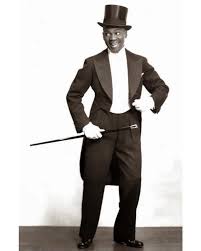Tap Talk: Bill Bojangles Robinson and 4/4 Time
- Susan Harvey
- Feb 11
- 4 min read
Updated: Feb 20
The Smooth Genius of Bojangles
This clip shows Bojangles at his smoothest, doing the stair dance. It comes from an idea initially introduced as a set performance piece by Al Leach in 1880, but there was something special about the way Bill Bojangles Robinson performed it. A reviewer for the New Yorker wrote:
“Bill Robinson just keeps on 1-2-3-4, 1-2-3-4 in regulation beat, slow measured and indescribably liquid, like a brook flowing over pebbles.”
What Is 4/4 Time?
4/4 means a piece of music has 4 crotchets in a bar and is counted 1-2-3-4, 1-2-3-4. Unlike a waltz which has 3 crotchets in a bar and counts 1-2-3, 1-2-3. Bojangles modelled himself on his hero, George Primrose (1852-1919) who was considered the very best exponent of soft shoe. Unlike the amazing Nicolas Brothers
Bill Robinson’s tap is close to the ground, on the toes and has no tricks or flashness. It’s just a steady flow of beat and rhythm. Another reviewer of the day wrote:
“All you have to have is a God given genius and take your time.”
Fascination and Fame
People were fascinated by Bojangles art. When he went into Vaudeville, he was so unbelievably popular, he earned $6,500 per week, the equivalent of $200,000 today. Then, when he joined ranks with the young Shirley Temple, he was in his fifties and his earnings rocketed to $27,000 a week, the equivalent of $650,000 today. From this clip, you can understand why another reviewer called his dancing:
“the music of raindrops on a tin roof.”
The Roots of Soft Shoe and Cultural Fusion
I wondered about 4/4 time and Bojangles popularity, and why soft shoes was so popular. Many cultures have some form of dancing that makes foot sounds. Flamenco, for instance is danced in various beats with foot stamps in one time signature being offset by hand clapping in another time signature. Sadly many dance forms are now rare treasures, lost in the mists of time and we do not know their time signatures. I think that soft shoe or shuffle as tap used to be called was the result of entirely different cultures suddenly living together and mixing their dance styles into a new unity.
The Historical Context
Historically, Bill Bojangles Robinson was born in 1878, when Queen Victoria was on the throne in Britain. It was a tumultuous time: worlds fell apart, societies crashed and people moved to the new land, the Land of the Free. America took in millions of immigrants, mostly from Great Britain, Norway, Germany and Prussia. Then, 1.5 million Irish fled there to escape the terrible Potato Famine. I think this kick started the mixing of many dance forms, new combinations, which formed new dance styles, and a new blending.
The Influence of Lancashire Clog Dancing
Traditional Irish dancing
The Irish brought with them not only 4/4 time or common time, but their dance was full of 68 (6 quavers to the bar) and 12 8 which is 12 quavers to the bar. It seems to me that the Irish escapees from starvation and oppression came to the new land wanting to be clean and square. In America, city streets have a four square grid pattern and during the Gold Rush (I848-1850) the land was allocated in one mile square plots. I have a feeling that all this squareness is reflected by 4 beats to the bar. It could not have happened in Scotland or Yorkshire because there are no flat plains: it’s all hill and dale. British towns follow the curve of a river bed, or the slope of a mountain, their old music had a lilt, a 68 pattern of 6 quavers in a bar, usually counted 1 and a, 2 and a.
Lancashire Clog
A Melting Pot of Dance
Bojangles soft shoe was blended with the Jig from Ireland and the clog from the Lancashire mining villages. Of course Irish jig has lasted independently and continues to be performed in both America and Ireland in a fixed form and became explosively popular with Lord of the Dance. The Lancashire Clog was danced in clogs, with leather uppers and a sole cut from alder or sycamore. This was the usual everyday footwear for working people all over Britain until the 1920s, when metal strips on toe and heel were added to reduce wear. With the great migration, there was a big mixing pot. African people, newly freed from slavery came to the towns where immigrants from Europe were also trying to build a new life in a new place. Somewhere in all this confusion, alien dance forms combined and the soft shoe was born.
The Timeless Joy of Soft Shoe
It was not a revolt, but a gentle mellowing. Mr Bojangles dancing is easy. There is no stress or strain, but a continuous, mellifluous flow. After all the trouble and strife people had escaped from, it was a change into softness and fun. For this first generation of tap enthusiasts, it wasn’t the complexity or acrobatics that made tap dance satisfying, it was the lilt and the flow. And the FUN!!!
from 1.51 onwards
Final Thoughts
Bill ‘Bojangles’ Robinson’s dancing was born from cultural unity, historical change, and artistic genius. His legacy lives on as a reminder that dance can be soft, rhythmic, and full of joy.
What do you think of soft shoe tap?
Let us know your thoughts or share your favourite tap performances with us!




Comments